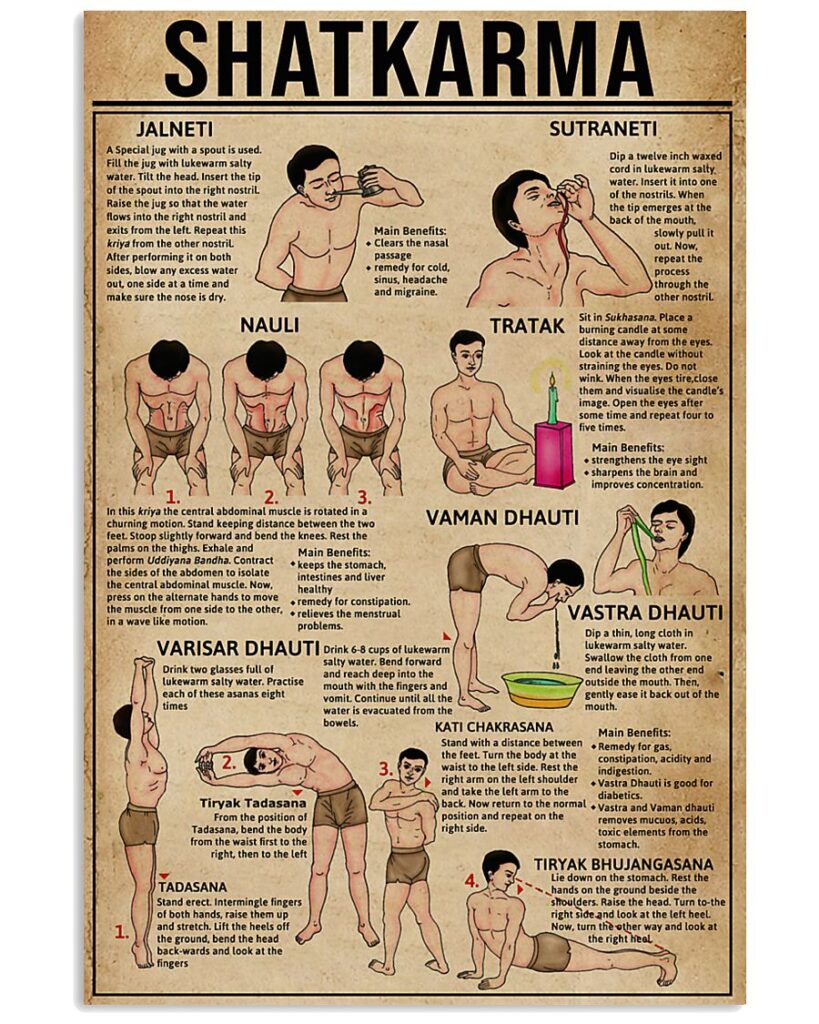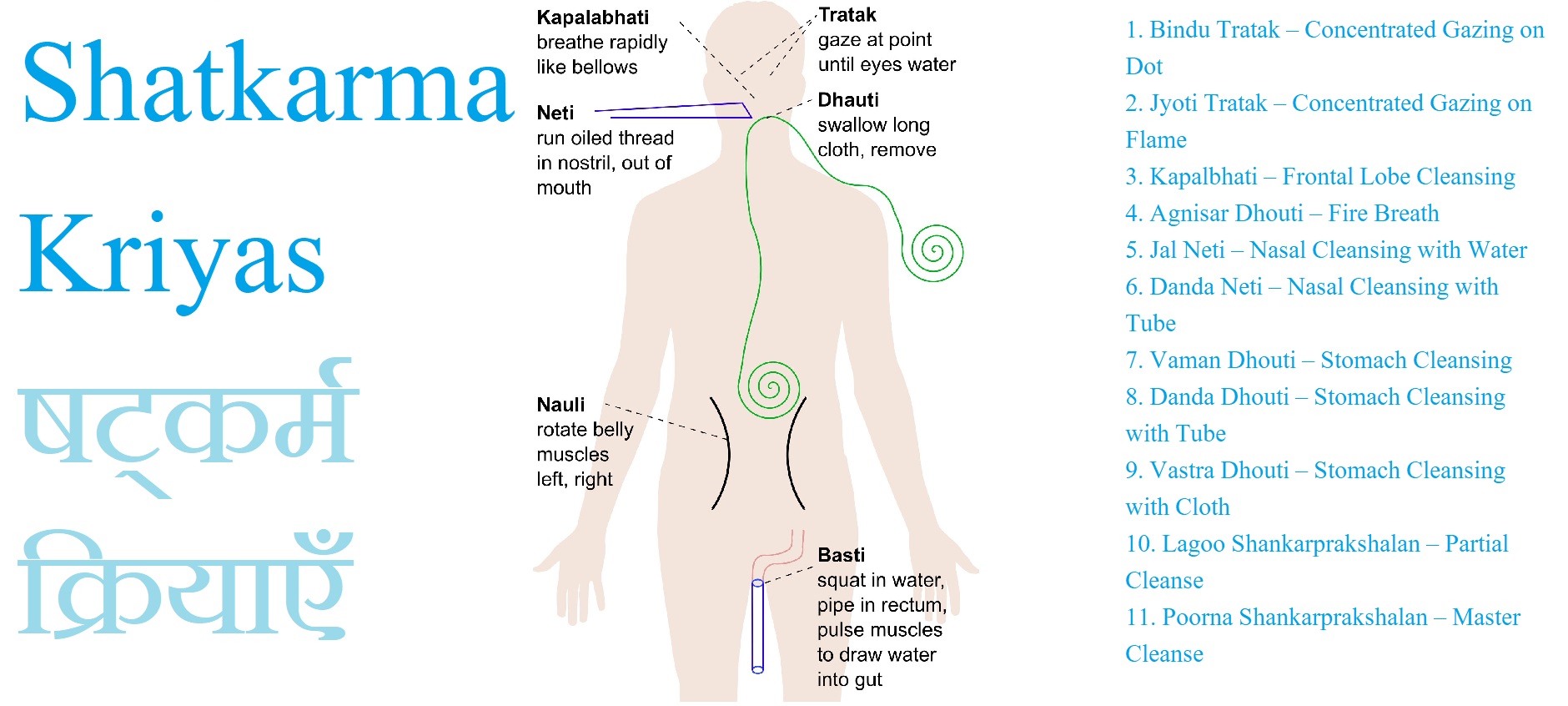Introduction
One of the main purposes of Hatha Yoga is to attain control over the breath, but this is difficult unless the body is purified or balanced first.
The Shatkarma Kriyas (six purification processes) mentioned in the Hatha Yoga Pradipika are:
- Dhautī – Internal Cleansing
- Basti – Yogic Enema
- Netī – Nasal Cleansing
- Naulī – Abdominal Massage
- Trāṭaka – Eye Cleansing
- Kapālabhātī – Frontal Brain Cleansing and Cleansing of Lungs
Let us understand the concept behind Shatkarma Kriyas in the context of Hatha Yoga.
Concept behind the practice
According to Ayurveda, there are three humours in the body:
- kapha (mucus)
- pitta (bile)
- vata (wind)
These are called the three doshas or tridosha.
These three functioning together facilitate bodily functions. However, if there is an excess of one or shortage of another, i.e., there is an imbalance between the three then ailments/illnesses develop. These ailments can be attributed to a lack of heat or excessive heat in the body [1].
It is generally recommended that before commencing pranayama or advanced yoga/meditative practices like dhyana, any imbalances in the doshas should be corrected. These imbalances manifest in the form of:
- excessive body fat (which might make the practitioner lethargic and reduce mobility)
- digestive problems (acidity and constipation)
- mucus congestion in the respiratory tracks, etc.
Hatha yoga gives six particular practices for the purpose of balancing the doshas.
These practices collectively are called Shatkarma Kriyas. Shat means ‘six’ and karma means ‘action.’

Techniques
The video below describes these techniques in detail comprehensively. Writing a few lines about these techniques in paragraph form would not do justice to them. These practices are very powerful and an in-depth explanation about them from an expert is necessary. Watch the whole video carefully to understand Shatkarma.
Benefits
These shatkarma which effect purification of the body are secret. They have manifold, wondrous results and are held in high esteem by eminent yogis [1]
– Hatha Yoga Pradipika, ch. 2, v. 23
According to a research paper [4], the benefits of Shatkarma practices were mentioned as :
The practice of dhauti was found to enhance respiratory functions and was useful in digestive disorders. Nasal cleansing, neti was particularly found beneficial in managing the rhinosinusitis in age groups ranging from children to adults. Although trataka practice was found to enhance cognition and bring a state of relaxation, but there was no evidence supporting its role in eye disorders. Kapalabhati practice appears to have a beneficial role in the activation of sympathetic nervous system, enhance cognition, and improve overall metabolism. Further large-scale clinical trials with robust designs are warranted to evaluate the effects of Shatkriya in health and disease. - P.S. Swathi Et.al, Journal of Ayurveda and Integrative Medicine, 2021
Precautions / Warnings
- Shatkarma is particularly advised only for those who have disturbances or imbalances in their doshas.
- These are very powerful practices that are difficult to learn just through books or YouTube where they might be taught by inexperienced practitioners.
- These practices require adequate experience and knowledge. The teacher must have mastered these techniques so that nuances of the student can be properly addressed.
- In case, a Guru or Teacher is not available, the practitioner should practice these exercises just the bare minimum, i.e., for the smallest possible time, all the while listening to the body and how it responds.
- Never do these practices aggressively as a beginner.
- For practices which require insertion of foreign equipment like thread etc. inside the body, always do them under the guidance of an expert Yoga or Ayurveda Practioner.
- Pregnant or Lactating women, elderly people and those with helth conditions should always consult a professional Yoga practioner before performing these exercise.
Conclusion
According to Swami Muktibodhanada of Bihar School of Yoga, these practices were not designed for therapy alone (i.e. for psychological matters).
They were created as an initial step for preparing the mind and body for further yogic practice. These practices if done properly, allow the body to be able to concentrate better and move towards dhyana (“continuous flow of the same thought or image of the object of meditation, without being distracted by any other thought” [2]).
References
- Book: Hatha Yoga Pradipika: Light On Hatha Yoga, by Swami Muktibodhananda
- Book: The Yoga sūtras of Patañjali, translated by Edward Bryant
- Book: Hatha Yoga, The report of a personal experience, by Theos Bernard, Published by Rider & Company
- Research Paper: P.S. Swathi, B.R. Raghavendra, Apar Avinash Saoji, ‘Health and therapeutic benefits of Shatkarma: A narrative review of scientific studies’, Journal of Ayurveda and Integrative Medicine, Volume 12, Issue 1, 2021

5 thoughts on “Shatkarma: Steps before higher practices in Yoga”